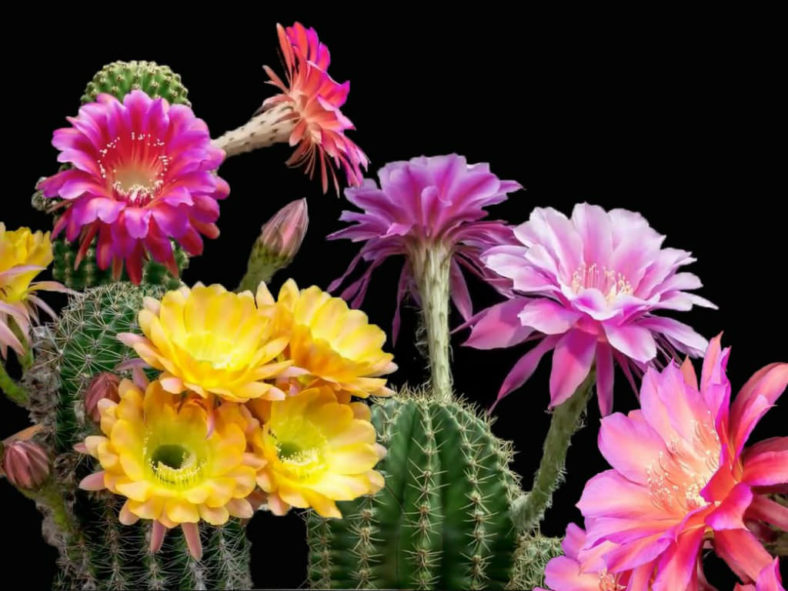Cacti are flowering plants, so they can bloom when they are mature. Whether or not an individual cactus blooms depends on its age and the care it gets. Some cacti do not bloom until they are more than 30 years old. Others will not bloom, even if they are old enough, unless they get proper light, watering, and fertilizing, especially potted cacti. Indoor Holiday Cacti, such as Christmas Cacti, will not bloom unless they get long nights and short days.
Columnar Cacti
Tall columnar cacti often take years before they bloom for the first time if grown from seed. If you root a branch from a mature, already-blooming columnar cactus, it will continue blooming after being separated from the mother plant and rooted. However, some cacti, such as Saguaro (Carnegiea gigantea), native to Arizona in USDA plant hardiness zones 9 through 11, have branches that will not root, so Saguaro must be grown from seed, with a 40- to 55-year wait for the first flower. Some columnar cacti that produce flowers for the first time after 10 to 20 years and can live outdoors in USDA zones 9 through 11 are the Peruvian Apple (Cereus repandus), Senita Cactus (Pachycereus schottii), and Mexican Fence Post (Pachycereus marginatus). Nevertheless, columnar cacti are effective landscaping plants even without flowers.

Short-columnar Cacti
Short-columnar cacti with mature stems below 2 feet (60 cm) tall usually flower within five years from germination. Echinocereus are native to the United States and Mexico and make mounding clumps of many stems over time. Large, pink, magenta, or red flowers are abundant in spring. Depending on the species, Echinocereus grows in USDA plant hardiness zones 5, for red-flowered, short Claret Cup (Echinocereus coccineus), through 11. Easter Lily Cactus (Echinopsis oxygona and hybrids) is hardy in zones 8 through 11. They produce huge, funnel-shaped flowers ranging in color from white, pink, lavender, and magenta to red. For the size of the plant, Peanut Cactus (Echinopsis chamaecereus) produces large flowers. Stems up to 6 inches (15 cm) long, covered with weak, white spines, crawl along the ground, and produce abundant bright orange flowers over 1 inch (2.5 cm) wide in spring. Peanut Cactus grows outdoors in zones 8 through 11.
Round Cacti
Some of the most floriferous cacti, such as Mammillarias and Rebutias, belong here. They usually bloom within 3 to 4 years after sprouting. Mammillarias are native to the United States and Mexico, producing star-shaped flowers in a ring around the top of the stem. Although round when young, some elongate to small columns. Flowers are white, pink, magenta, lavender, red, yellow, or green. They are plants that grow outdoors in USDA zones 8 through 10. Rebutias are native to South America. Tidy low-growing plants cluster with age, and red, yellow, orange, or purple flowers come from near the base of the stem. Rebutias are hardy in USDA zones 9 through 11.
Conditions that Encourage Bloom
Since cacti grow as container plants in any USDA zone, give them proper care, and they will reward you with blossoms. Most cacti need at least 4 hours of sunlight daily, preferably morning sunlight. Water them regularly during the growing season, allowing the top inch or two (2.5 to 5 cm) of soil to dry before watering again until water comes through the pot's drainage holes. Do not let water remain in the pot saucers. Use a well-draining soilless potting mix. Fertilize them monthly from when they begin the spring growth to the end of summer with a half-strength low-nitrogen high-phosphorus formula, promoting bloom. Allow the cactus to become somewhat pot-bound for best blooming. Decrease watering in winter, and give your cacti a winter dormancy period with lower temperatures.
Holiday Cacti
Christmas Cactus (Schlumbergera × buckleyi) and Thanksgiving Cactus (Schlumbergera truncata) look so different than desert cacti that some people are surprised they are cacti. They look different because they grow on Brazilian rainforest trees as epiphytes, and their stems are flattened and green, looking leaf-like. Therefore, they need care that is different from that of desert cacti. Holiday Cacti are triggered to bloom in fall and winter by cooling temperatures, increasing night length, and decreasing day length with only 8 to 10 hours of light. Therefore, they prefer partial shade most of the year but can grow in sunlight in fall and winter.
Source: sfgate.com
Links
- Succupedia: Browse succulents by Scientific Name, Common Name, Genus, Family, USDA Hardiness Zone, Origin, or cacti by Genus